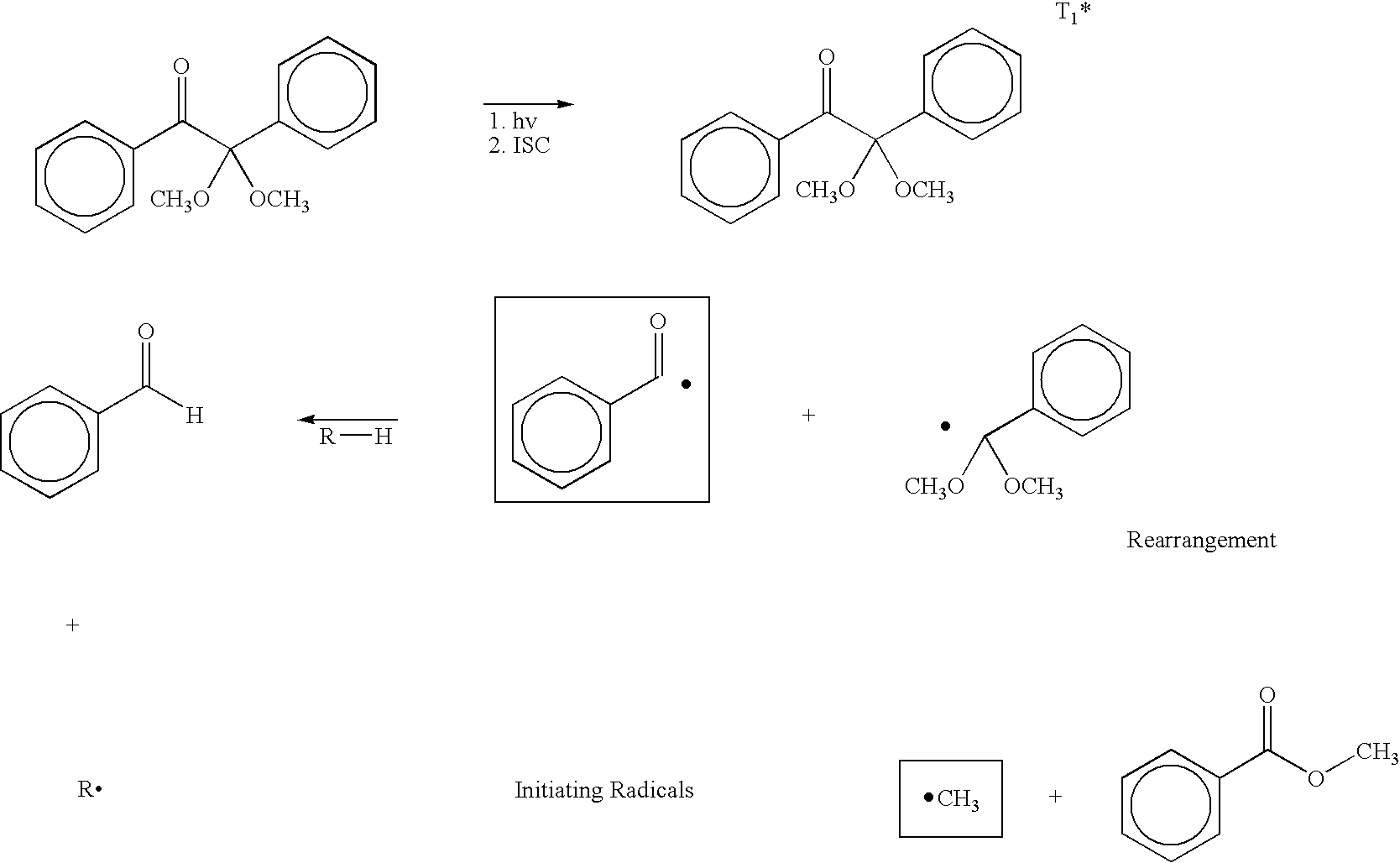Class of amine coinitiators in photoinitiated polymerizations
a technology of photoinitiation and amine, which is applied in the field of class of amine coinitiators in photoinitiated polymerization, can solve the problems of poor weatherability, low product yield, and low reaction speed of amines, and achieves low extraction rate, low viscosity, and low cost.
- Summary
- Abstract
- Description
- Claims
- Application Information
AI Technical Summary
Benefits of technology
Problems solved by technology
Method used
Image
Examples
example 1
Photo-DSC Experiments
[0057] The evaluation of long chain alkylamine coinitiators of this invention was performed in comparison to MDEA incorporated as a coinitiator. These photo-DSC experiments were performed on a Perkin-Elmer DSC 7 modified to incorporate a medium pressure mercury lamp from Ace Glass. The light is passed through the DSC sample head through two quartz windows to allow for the irradiation onto the sample and reference cells. The intensity was 30 mW cm−2. 2 μL samples were introduced into specially crimped aluminum DSC pans with thicknesses in the range of 180-250 μm. Photo-DSC exotherms were acquired by Perkin-Elmer Pyris software and further manipulation of data and plotting was performed using standard spreadsheet programs. Representative photo-DSC data for HDDA formulations initiated by benzophenone in the presence of an amine synergist are summarized in Tables 1 and 2. Light intensity in the runs in Table I was 67.2 mW / cm2 at full arc under N2 purge. It was det...
example 2
Synergistic Amine Blends
[0059] As noted earlier, certain short chain amines have been shown to provide synergistic results in blends of this invention. In order to test the synergistic behavior of certain short chain amines when used in combination with long chain trialkylamines, pre-blends were prepared in the following way and comparatively tested with a blend of long chain amines only.
Pre-Blend 1:
[0060] 70% Dodecyldimethylamine (ADMA® 12 amine; Albemarle Corporation) [0061] 30% N,N-dimethyl-4-morpholineethanamine (DABCO® XDM; Air Products, Inc.)
Pre-Blend 2: [0062] 63% Dodecyldimethylamine (ADMA® 12 amine; Albemarle Corporation) [0063] 23% N,N-dimethyl-4-morpholineethanamine (DABCO® XDM; Air Products, Inc.) [0064] 10% HMPP [2-hydroxy-2-methyl-1-phenylpropane-1-one, a cleavage type photoinitiator (FirstCure® photoinitiator; Albemarle Corporation)]
Pre-Blend 3: [0065] 90% Dodecyldimethylamine (ADMA® 12 amine; Albemarle Corporation) [0066] 10% HMPP [2-hydroxy-2-methyl-1-phenyl...
example 3
[0076] A series of performance tests of various photocuring formulations was performed. The monomers used, TMPEOTA and TRPGDA, were obtained from UCB Chemicals Corporation. Methyldiethanolamine (MDEA), benzophenone (BP) and hydroquinone monomethyl ether (MEHQ) were obtained from Aldrich and used without further purification. DC-57 and FC-430 were obtained from Dow Corning and 3M. All formulations were mixed and allowed to set for 24 hours, at which point viscosity was measured. Viscosities of the formulations were performed at 25° C. with a Brookfield LV viscometer using a #2 spindle at 100 rpm. The formulations were then applied to Leneta charts (Form 5C) using a No. 3 wire wound rod, and cured under a Fusion H lamp at 145 fpm (35 mJ cm−2 of UVC). The formulations are as listed in Table 4 below; all values given (except viscosity) are in weight percent. Abbreviations are the same as in the preceding Examples.
TABLE 4FormulationFIRSTCURE AS-1FIRSTCURE AS-3Amine FunctionalAmine Func...
PUM
| Property | Measurement | Unit |
|---|---|---|
| thickness | aaaaa | aaaaa |
| speeds | aaaaa | aaaaa |
| wavelengths | aaaaa | aaaaa |
Abstract
Description
Claims
Application Information
 Login to View More
Login to View More - R&D
- Intellectual Property
- Life Sciences
- Materials
- Tech Scout
- Unparalleled Data Quality
- Higher Quality Content
- 60% Fewer Hallucinations
Browse by: Latest US Patents, China's latest patents, Technical Efficacy Thesaurus, Application Domain, Technology Topic, Popular Technical Reports.
© 2025 PatSnap. All rights reserved.Legal|Privacy policy|Modern Slavery Act Transparency Statement|Sitemap|About US| Contact US: help@patsnap.com


